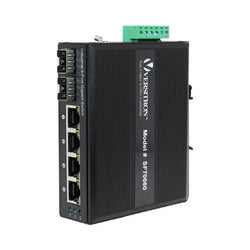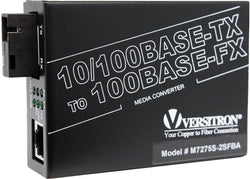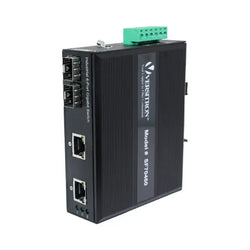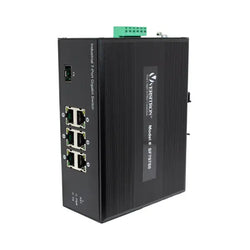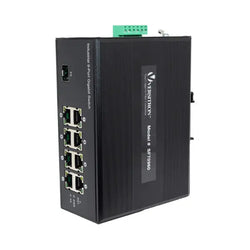Unmanaged Switches
Unmanaged switches are basic “plug-and-play” style devices that allow a user to connect multiple Ethernet and Fiber Optic devices with ease. With an unmanaged ethernet network switch, setup time is greatly reduced due to the simplistic nature of the devices. The fixed configuration provided by these switches is great for smaller networks where traffic is not required to be monitored or controlled such as a single home, a small business network, a single office, etc. Since there is no ability to control the ports on these devices, unmanaged network switches use auto-negotiated ports to determine data rate/network speed as well as whether to use full or half duplex modes. Unmanaged switches provide you with a cost-effective solution while still allowing your fiber and Ethernet devices to communicate with each other in a basic configuration.
VERSITRON provides a broad selection of unmanaged switches with fast Ethernet and gigabit combo ports in 2, 4, 6, and up to 48 port size configurations. Our unmanaged ethernet switches come with 1-2 100/G SFP Slots.
How Does an Unmanaged Network Switch Work?
Every data packet comes with the MAC address. The unmanaged gigabit switch identifies this address and creates an internal address table with a MAC table and corresponding port. When the device sends a data packet to another device, this data passes through the switch. This switch reads the data header to check the destination address and accordingly transfers the data packets to the destination devices through the most appropriate ports.
Features of VERSITRON’s Unmanaged Ethernet Network Switches
Our unmanaged network switches possess the following features:
- They feature RJ45 and SFP ports. The RJ45 ports support 10/100/1000Mbps-Full/Half-duplex, Auto-Negotiation, Auto-MDI/MDIX.
- These switches prevent packet loss w/back pressure (half-duplex) and IEEE 802.3x PAUSE Frame Flow Control (Full-Duplex).
- Our unmanaged gigabit switches are available for multimode or single mode fiber over a variety of link budgets.
- Unlike some competitor models, these switches require no in-field optical adjustments.
Frequently Asked Questions on Unmanaged Network Switches
Unmanaged network switches are one of the popular items in our inventory. We have been delivering these switches for various commercial, residential, and industrial applications for several years now. Our experts often tend to answer several questions on these switches. Here, we have consolidated a few commonly asked questions in this segment.
- Where can I use an unmanaged network switch? Unmanaged ethernet network switches are used to connect devices in standalone networks. They are also used to connect edge devices on network spurs. These switches possess simple designs, which makes them an ideal choice for applications where the users may be looking for hassle-free installations. It is quite common to find them in small offices, where these switches are used to install IP-based surveillance cameras and wireless access points. These switches can also be used to add temporary workgroups in large networks.
- Can I use a managed switch as an unmanaged network switch? Yes, you can use a managed switch as an unmanaged network switch. For this, you have to use the managed switch with no configuration set up in Open Mode. In this type of setup, the switch and all its ports will be set to the default VLAN.
- Is it possible to run VLANs on an unmanaged switch? No, but it can be possible in certain scenarios. These switches are not designed to support the VLAN concept. It is assumed that all devices belong to the same domain. If all devices are plugged to the same unmanaged switch then running VLAN is possible. However, if you plan to use multiple VLANs on the switch, then you need to choose a managed vlan switch.
- What are some potential applications of Ethernet unmanaged switches? These switches are used in the following applications: Military: Unmanaged Ethernet switches are an integral part of naval submarine applications and are often used alongside managed switches. These switches provide isolation in data communication applications. Education: Our unmanaged fiber switches are used in the education industry as a part of controlled broadcasting. Unmanaged switches can be used for open-access applications such as digital notice displays.
- Can anyone tamper with these unmanaged network switches? It will depend on how and where you plan to use these switches. These switches come with basic security features like a port cover, which is lockable. This helps avoid any kind of tempering. Like managed switches, these switches do not have programmable features, which is why we recommend you always use them in locations that are guarded by surveillance cameras.
- How can I connect unmanaged network switches to the network? Is any technical knowledge needed to install these switches? As we have already indicated, these switches are simple plug-and-play types and can be handled easily. These switches are generally used to increase the number of Ethernet ports in the network. You can connect a router or any other switch ports to the unmanaged gigabit switch and the end devices like computers can be connected to it.
- Do these switches have MAC addresses? No, they do not possess MAC addresses. Unmanaged gigabit ethernet switches always create MAC address tables on their own to forward frames.
- Do these switches have IP addresses? Can I manage them if required? These switches are simple plug-and-play types and do not have IP addresses.
- How to set up an Ethernet unmanaged switch? The setup and installation vary across models. Follow the below-given steps if you are using our 6-Port 10/100/1000Base Switch with (2) 1000Base SFP Slots - SG70660 switch.
- Check the SFP slots on the switch and install a fiber optic SFP module in it.
- Insert the fiber optic cable in the SFP module to the fiber network.
- Connect the UTP cable from the network device to the RJ-45 port on the SG70660.
- Connect the power adapter to the switch and check if the LED lights lit up on the switch.
- All LED lights will glow if the SFP LEDs and TP Act are properly inserted.
Want to learn more about unmanaged switches? Check out our in-depth guide on what is an unmanaged switch


